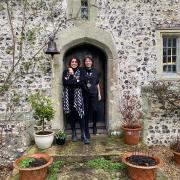Oxford graduate Charles Winchester found that environmental jobs in far-flung places made him want to “give something back” nearer to where he grew up

In March this year, the South Downs National Park celebrated its tenth anniversary. The newest of the UK’s 15 national parks, it’s had a terrific first decade, with much having been achieved since it came into existence back in 2010.
Crucial to its success is the work of the park’s rangers, who play a vital role in enhancing and conserving its landscape, biodiversity and cultural heritage.
One of these rangers is Charles Winchester, who has worked for the National Park since 2017. The Oxford graduate’s patch is centred on Petworth in the park’s Wealden Heath area, with his role being - as he explains - “to help conserve and enhance the landscape on the ground. The department that I’m a part of is called Countryside Policy and Management - CPM for short - which, as the name suggests, broadly focuses on the policy and land management side of things for the National Park,” he explains.
Within his patch, Charles acts as the first point of contact for the South Downs National Park Authority (which manages the 1,627-square kilometre park), also working on the planning and organisation of park projects.

“One day could involve tonnes of meetings with partners to plan and organise a project, and the next, we could be doing something quite practical,” he notes. “For example, we do riverfly monitoring, so that means getting waders on and getting into the river and monitoring the invertebrate populations.”
The South Downs National Park covers an area from Winchester in Hampshire (making Charles’ surname particularly suited to his role) to Eastbourne in East Sussex. It has the unique status of being the most populous National Park in the UK, with 117,000 people living and working within it, and two million additional people living within five kilometres of it.
As Charles explains, rangers at the park (which currently has a focus on nature recovery) work with a variety of parties, from conservation organisations like the National Trust and the RSPB to farmers and landowning estates such as Goodwood and Cowdray.
MORE: Meet the woman in charge of our most famous historical sites including Battle Abbey

Growing up on a farm near Battle, Charles has always had a keen interest in the environment and the outdoors. After studying geography at Oxford as an undergraduate, he did a master’s degree there in biodiversity and conservation, completing his studies in 2011.
Since university, he has held a number of environmental jobs, working in places as far-flung as Australia, Belgium and the US. However, Charles - who was working for the High Weald Area of Outstanding Natural Beauty when he saw an advert for a job at the South Downs National Park - actually notes that it was his experiences abroad which led him to want to “give something back” nearer to where he grew up.
“I think the international experience really helped me decide what I wanted to do,” he reflects.
The ranger says that his favourite things about the South Downs National Park are its agricultural heritage and the drama of its landscape. As someone who also lives within the park itself – in a village north of Chichester – he enjoys getting out and visiting new and more familiar areas in his spare time.

He notes: “I’m really lucky in that I can step straight out of the front door and there’s an amazing network of footpaths and bridleways for me to go and explore.”
Recently, Charles has been working with a local school to plant a hectare of species-rich chalk grassland, with the ranger hoping to develop this initiative in the coming years.
He’s also in the process of launching a project to create a number of walks for people with differing mobility levels for the Serpent Trail, a 64-mile footpath stretching from Haslemere in Surrey to Petersfield in Hampshire that links the South Downs National Park’s heathland areas.
“The ambition there is to make sure that as many people as possible can enjoy these heathland sites, whatever their level of mobility,” Charles explains.
National Parks cover one tenth of the UK’s landmass, and Charles and his colleagues have witnessed a new wave of interest in connecting with nature and being outdoors as the world comes to terms with the coronavirus pandemic.
“I think there’s been a new appreciation of the importance of nature and the benefits it can bring to health and wellbeing, and it just shows that people really need green spaces like National Parks more than ever,” he reflects.
What’s more, with climate change and biodiversity having moved up the world agenda, Charles feels that now is a great time to be working in the National Park.
“I think we’re all really excited to see what the next decade brings and what we can achieve to conserve and enhance the landscape,” he says.




























